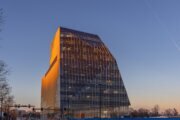D.C. Mayor Vincent Gray’s proposal to build a new soccer stadium for D.C. United at Buzzard Point would generate about $109.4 million in net fiscal benefits and support nearly 1,700 full time jobs in the District over the next three decades.
The stadium, however, would also be the most expensive in Major League Soccer, with a price tag of $286.7 million, and there are plenty of things that could go wrong to either derail or add costs to the project. Those are some of the major takeaways from a 400-plus-page cost analysis released Wednesday morning as the D.C. Council prepares to hold a roundtable on whether to move forward with the multimillion-dollar economic development initiative.
Council Chairman Phil Mendelson delayed the report’s release until after Tuesday’s mayoral election, which Councilwoman Muriel Bowser won. The council now has three scheduled legislative hearing dates before the close of the year. If it’s unable to pass the proposal by then, the process would likely need to start over under Mayor-Elect Bowser’s administration.
The c ouncil decided in the spring to seek an independent review of the D.C. United stadium deal and retained Conventions, Sports and Leisure International, Integra Realty Resources and the Robert Bobb Group to assess the project’s proposed costs and benefits. On the plus side, the report noted, the project would net new direct, indirect and induced spending of $2.6 billion from 2015 through 2046, supporting 1,683 full- and part-time jobs generating personal earnings of about $1.3 billion. It would also speed up additional development in the area surrounding Buzzard Point. No significant development is expected there for eight to 10 years at a minimum without the new stadium.
There are plenty of costs and questions, as well. The report indicates the land the District needs to acquire for the stadium is overvalued by at least $19.4 million, and the Reeves Center, which it would swap with Akridge as part of the deal, is undervalued by $11.2 million. Combined, the report concludes, the net overpayment is about $25.7 million. The report floats the prospect of the District taking the land it needs by eminent domain but cautions there are additional costs, including legal fees, associated with that process. The District’s proposed Stadium Act also authorizes sales and real estate breaks worth about $50 million.
The report also raises a host of risks that could alter the stadium debate:
• The District’s acquisition and preconstruction costs could exceed a $150 million cost cap.
• The District could spend that $150 million only to see D.C. United fail to build the stadium.
• D.C. United could be unable to secure financing for its share of the project costs. The franchise hasn’t submitted plans for how it will finance the stadium or related development projects, including a hotel, and the District will have committed most or all of its investment before the team needs to lock in that financing.
• The uncertainty surrounding the funding, development, design and schedule for the District to build a new municipal center in Anacostia Gateway to replace the Reeves Center that it has promised to Akridge in exchange for a portion of the stadium’s footprint.
• The uncertainty surrounding environmental cleanup costs before construction can start.
• The uncertainty surrounding funding for future stadium renovations, upkeep and improvements. Stadium owners will typically need to seek public financing for those projects as they reach their 10 or 15 year anniversary.
• Risks associated with the District’s property tax and financial projections. DC Stadium LLC could seek a property tax exemption or discounted property assessment value, eliminating or reducing property taxes paid to the District after the proposed real estate tax breaks lapse.
• Uncertainty surrounding D.C. United’s financial performance and that of the stadium itself. Revenue could be less than projected due to factors including a prolonged economic downturn, poor business practices, and lower attendance or revenue, all of which would lessen the estimated net benefits to the District.
While the stadium would be the most costly in the MLS, with the average hovering at around $160 million, the report notes the District’s share would only be about 46 percent and the private sector would cover the remaining 54 percent, or about $155.6 million. That mix is in keeping with similar MLS stadium projects, with a typical split of 44 percent for public sector costs and 56 percent private.
The report concludes that the proposed land swap between Akridge and the District is “based on sound land values” but raises questions about the fair value for the Reeves Center and related pieces. It estimates Reeves is worth about $66.8 million, while the negotiated price for its sale to Akridge is about $55.58 million. The land Akridge would trade for it, the report concludes, is fairly priced at about $21 million. Akridge revealed earlier Wednesday changes it hopes will address additional concerns about the proposal, including an option for the District to roll back the land deal if D.C. United is not able to meet its obligations.
Several other properties the District needs, including those owned by Pepco, Super Salvage and Mark Ein, are overvalued by $8.3 million, $7.2 million, and $3.9 million respectively, though include catches including costs to relocate Pepco’s substation elsewhere.







